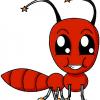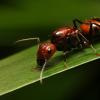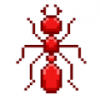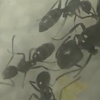- Formiculture.com
- Forums
- Gallery
- Members
- Member Map
- Chat

Inbreeding, is it possible?
Started By
Senile Santa
, May 19 2016 1:18 PM
inbreeding inbred queen ant nuptial flight fertile
9 replies to this topic
#1
 Offline
-
Posted May 19 2016 - 1:18 PM
Offline
-
Posted May 19 2016 - 1:18 PM
Do captured colonies produce male and pre-queens during nuptial flight? If they do, is it possible to have them to mate and have fertile queens?
#2
 Offline
-
Posted May 19 2016 - 1:28 PM
Offline
-
Posted May 19 2016 - 1:28 PM
Not likely, since most colonies will fly and mate in the air with other colonies that are flying, and queens will mate with more than just 1 male. I'd say they have pretty diverse genes.
Although not too sure on species that mate in the nest.....
#3
 Offline
-
Posted May 19 2016 - 1:40 PM
Offline
-
Posted May 19 2016 - 1:40 PM
Do captured colonies produce male and pre-queens during nuptial flight? If they do, is it possible to have them to mate and have fertile queens?
It is very uncommon for this to happen and for most species they don't. I know that Myrmica rubra has been known to do this before.
Currently Keeping:
Trachymyrmex septentrionalis
Pheidole pilifera
Forelius sp. (Monogynous, bicolored) "Midwestern Forelius"
Crematogaster cerasi
Pheidole bicarinata
Aphaenogaster rudis
Camponotus chromaiodes
Formica sp. (microgena species)
Nylanderia cf. arenivega
#4
 Offline
-
Posted May 19 2016 - 1:48 PM
Offline
-
Posted May 19 2016 - 1:48 PM
I have Pseudomyrmex pallidus colony that flew in captivity where inbreeding took place. The mated queen shed wings and went back to the same colony. I wanted to know if the mated queen that shed wings can reproduce so i captured the queen and kept her individually. She started to lay eggs and slightly more than a month later workers emerged.
#5
 Offline
-
Posted May 19 2016 - 3:15 PM
Offline
-
Posted May 19 2016 - 3:15 PM
Ok,I was wondering if you set up a large mating place. Like if you hooked large tubes to the top of the out world to simulate them leaving and made a loop so that it seems like they were flying a large distance. Then just pick the fertile queens from the tube. Just an idea haha
#6
 Offline
-
Posted May 19 2016 - 6:20 PM
Offline
-
Posted May 19 2016 - 6:20 PM
what about species that have alates that mate within the nest like T. sessile and M. pharonis?
#7
 Offline
-
Posted May 19 2016 - 7:15 PM
Offline
-
Posted May 19 2016 - 7:15 PM
I've had Monomorium ergatogyna mate in captivity. So, Monomorium pharonis most certainly does too (and I believe Monomorium pharonis aren't native, think they are from Africa). Monomorium minimum also probably mate with each other, since they are VERY similar to Monomorium ergatogyna.
A lot of invasive species do. Argentine ants will. And my Pheidole megacephala mate in captivity. Pheidole megacephala even produce alates in captivity. Solenopsis invicta however is invasive, but needs to mate with other alates from other colonies. At least I'm pretty sure that is accurate.
Tapinoma sessile mate with each other in their nests, and bud out similar to Argentine ants. At least in an urban environment, Tapinoma sessile turns invasive. In their natural environment with only 100 or so ants in total, they might still do the typical mating flights. They are really hard to keep in captivity though (same with Argentine ants). Pheidole megacephala is really easy to keep, same with Solenopsis invicta.
Monomorium ergatogyna is super easy to keep in captivity (mostly), except they are really good escape artists. I'd say better than even Solenopsis molesta (or at least as good as).
#8
 Offline
-
Posted May 20 2016 - 2:27 AM
Offline
-
Posted May 20 2016 - 2:27 AM
Wild Tapinoma colonies are not limited in colony size of "a hundred or so". The colonies get massive.
Edited by gcsnelling, May 20 2016 - 2:31 AM.
- dermy likes this
#9
 Offline
-
Posted May 20 2016 - 7:43 AM
Offline
-
Posted May 20 2016 - 7:43 AM
Wild Tapinoma colonies are not limited in colony size of "a hundred or so". The colonies get massive.
Ah. I thought Tapinoma sessile were smaller in their natural environment, and they turned massive in when in an urban area. Sorry if that is wrong. A while back someone over on Antdude's forum said that, so maybe they were wrong too then.
#10
 Offline
-
Posted October 9 2016 - 7:13 PM
Offline
-
Posted October 9 2016 - 7:13 PM
Well, according to Ants Canada new studies shown more publicly, it seems Crazy Black Ants queens can make clones of themselves AND the males they mated with which when they become mature they can "imbreed" in a way that actually isn't imbreeding- It is just.... Mind boggling.
Also tagged with one or more of these keywords: inbreeding, inbred, queen, ant, nuptial flight, fertile
 |
Ants & Myrmecology →
General →
Ant Misinformation - Competent People WantedStarted by The_Gaming-gate , Mar 27 2024 |
|

|
|
Anting →
General Anting →
Queen ant!Started by cooIboyJ , Mar 6 2024 |
|

|
||
 |
Ant Keeping →
Ant Keeping Journals →
My C. chromaiodes JournalStarted by Artisan_Ants , Mar 3 2024 |
|

|
|
Ant Keeping →
Ant Keeping Journals →
The antperialist (ziyad)Started by Ziyadtheantperialist , Feb 29 2024 |
|

|
||
Ant Keeping →
General Ant Keeping →
Do Solonopsis molesta Need Diapause?Started by Artisan_Ants , Feb 16 2024 |
|

|
0 user(s) are reading this topic
0 members, 0 guests, 0 anonymous users


















